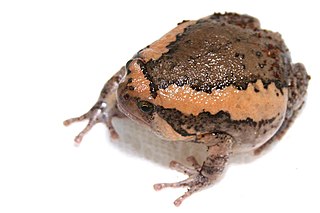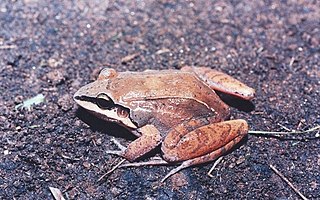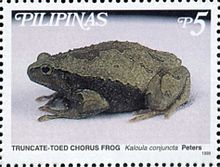
Kaloula is a genus of microhylid frogs found in southern and eastern Asia. They are sometimes known as the Asian narrowmouth toads.

The African common toad or guttural toad is a species of toad in the family Bufonidae. It is found in Angola, Botswana, Democratic Republic of the Congo, Kenya, Lesotho, Malawi, Mauritius, Mozambique, Namibia, Réunion, Somalia, South Africa, Ethiopia, Swaziland, Tanzania, Zambia, and Zimbabwe. Its natural habitats are subtropical or tropical dry forest, subtropical or tropical moist lowland forest, subtropical or tropical moist montane forest, dry savanna, moist savanna, temperate shrubland, subtropical or tropical dry shrubland, subtropical or tropical moist shrubland, subtropical or tropical dry lowland grassland, subtropical or tropical seasonally wet or flooded lowland grassland, subtropical or tropical high-altitude grassland, intermittent rivers, freshwater lakes, intermittent freshwater lakes, freshwater marshes, intermittent freshwater marshes, arable land, pastureland, rural gardens, urban areas, heavily degraded former forest, ponds, and canals and ditches.
The Philippine toad is a species of toad in the family Bufonidae. It is endemic to the Philippines. Its natural habitats are subtropical or tropical dry forest, subtropical or tropical moist lowland forest, subtropical or tropical swamps, subtropical or tropical moist montane forest, subtropical or tropical moist shrubland, intermittent rivers, swamps, freshwater lakes, intermittent freshwater lakes, freshwater marshes, intermittent freshwater marshes, intertidal marches, arable land, plantations, rural gardens, urban areas, water storage areas, ponds, aquaculture ponds, and seasonally flooded agricultural land.

Pelophryne lighti is a species of toad in the family Bufonidae.

Hyperolius parallelus, also known as the Angolan reed frog, is a species of frog in the family Hyperoliidae.

Leptodactylus bolivianus is a species of frog in the family Leptodactylidae. Its local name is sapo-rana boliviano.

Leptodactylus mystaceus is a species of frog in the family Leptodactylidae. It is also known as the common toad-frog.

Chiasmocleis albopunctata is a species of frog in the family Microhylidae. It is found in Bolivia, Brazil, and Paraguay. Its natural habitats are subtropical or tropical dry forests, dry savanna, moist savanna, subtropical or tropical moist shrubland, subtropical or tropical seasonally wet or flooded lowland grassland, intermittent freshwater lakes, intermittent freshwater marshes, arable land, pastureland, rural gardens, heavily degraded former forest, ponds, seasonally flooded agricultural land, and canals and ditches.

The Kalinga narrowmouth toad is a species of frog in the family Microhylidae. It is endemic to the Philippines. Its natural habitats are subtropical or tropical moist lowland forests, subtropical or tropical moist montane forests, arable land, pastureland, and plantations. It is threatened by habitat loss.
The Bicol narrowmouth toad or Catanduanes narrow-mouthed frog is a species of frog in the family Microhylidae. It is endemic to the Philippines, where it is found in the Bicol Peninsula and Catanduanes Island. Its natural habitats are subtropical or tropical moist lowland forests, subtropical or tropical moist montane forests, pastureland, plantations, rural gardens, and heavily degraded former forest. It is threatened by habitat loss.

The painted narrowmouth toad or slender-digit chorus frog is a species of frog in the family Microhylidae.

The Luzon narrow-mouthed frog is a species of frogs in the family Microhylidae.
Kaloula walteri is a species of frog in the family Microhylidae.
Oreophryne anulata is a species of frog in the family Microhylidae. It is endemic to the Philippines. Its natural habitats are subtropical or tropical moist lowland forests, subtropical or tropical moist montane forests, subtropical or tropical moist shrubland, freshwater lakes, intermittent freshwater lakes, and freshwater marshes. It is threatened by habitat loss.

The banded rubber frog is a species of frog in the family Microhylidae. It is found in central and southern Africa. Its natural habitats are dry savanna, moist savanna, subtropical or tropical dry shrubland, subtropical or tropical moist shrubland, subtropical or tropical dry lowland grassland, subtropical or tropical seasonally wet or flooded lowland grassland, subtropical or tropical high-altitude grassland, intermittent freshwater lakes, intermittent freshwater marshes, arable land, pastureland, water storage areas, ponds, and canals and ditches. The female can reach a maximum size of 65 mm whereas the tadpoles can reach a size of 37 mm. The maximum size of the male is yet unknown, but sizes differ from 45 mm to 68 mm.

The small disked frog or swamp frog is a species of frog in the family Dicroglossidae. It is endemic to the Philippines.

The Woodworth's frog is a species of frog in the Dicroglossidae family. It is endemic to the Philippines. Its natural habitats are subtropical or tropical moist lowland forests, subtropical or tropical moist montane forests, subtropical or tropical moist shrubland, subtropical or tropical seasonally wet or flooded lowland grassland, rivers, intermittent rivers, freshwater lakes, intermittent freshwater lakes, freshwater marshes, intermittent freshwater marshes, freshwater springs, coastal freshwater lagoons, arable land, pastureland, plantations, rural gardens, urban areas, water storage areas, ponds, aquaculture ponds, open excavations, irrigated land, and seasonally flooded agricultural land.

Platymantis corrugatus is a species of frog in the family Ceratobatrachidae. It is endemic to the Philippines, where it is found throughout the archipelago except Palawan. Its natural habitats are tropical moist lowland forest and subtropical or tropical moist montane forest. It is threatened by habitat loss. Platymantis corrugatus is one of the most common Platymantis species in the Philippines.

The marbled snout-burrower is a species of frog in the family Hemisotidae. It is found in sub-Saharan Africa. Its natural habitats are subtropical or tropical dry forest, subtropical or tropical moist lowland forest, dry savanna, moist savanna, subtropical or tropical moist shrubland, subtropical or tropical high-altitude grassland, swamps, freshwater lakes, intermittent freshwater lakes, freshwater marshes, intermittent freshwater marshes, arable land, plantations, seasonally flooded agricultural land, and canals and ditches. It is also called the mottled shovelnose frog and marbled shovelnose frog.
Hylarana grandocula is a species of true frog in the genus Hylarana. It is native to the islands of Basilan, Bohol, Camiguin Sur, Dinagat, Samar, and Mindanao in the Philippines. Its natural habitats are subtropical or tropical dry forest, subtropical or tropical moist lowland forest, subtropical or tropical moist montane forest, rivers, intermittent rivers, freshwater marshes, and heavily degraded former forest. It is threatened by habitat loss.
















